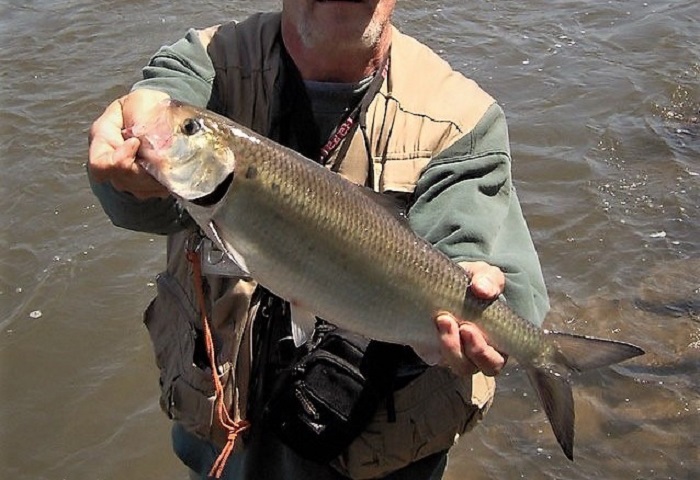
Maryland's Hickory Shad
Imagine a fish which is sleek, silver and strong that strikes lures with sledgehammer force and then gyrates in spectacular leaps propelling itself well above the surface. The runs and mad dashes are long and powerful, testing light tackle to the max. Now, envision that this fish has just traveled hundreds of miles and still has incredible strength for a fish that averages 16 inches long and weighs in at a two-pound average. Yes, we are talking about the hickory shad, a very welcome arrival to numerous Maryland tidal rivers each April and May.
WHERE:
Hickory shad crowd the upper reaches of tidal creeks and larger rivers in varying degrees throughout much of Maryland. The epicenter for hickory shad activity would have to be the Susquehanna River below Conowingo Dam and adjoining Deer and Octoraro Creeks in Harford County, where smaller stream environs add to the joys of hard-fighting fish in high numbers. Both spin and fly anglers don chest waders and cast shad darts, spoons or brightly colored flies to tempt these silver streaks and enjoy the ride of these high-flying “mini-tarpon.” Both wading and boat fishing options are available on the Susquehanna.

Other productive systems are the upper reaches of the Patuxent River on the Western Shore, the Wicomico on the Lower Eastern Shore (between Wicomico and Somerset County) and the upper reaches of the Choptank River in Caroline County and area tributaries where Maryland Department of Natural Resources survey crews have recently noticed much improved numbers of hickory shad. Reports of hickory runs in the Gunpowder, Chester, and other tributaries are circulating among the shad crowds. For other locations you might find this great gamefish, visit the Fishing Hot Spots map on the Maryland Department of Natural Resources Fisheries webpage.
TACKLE & TACTICS:
Although fly fishing can catch plenty of hickories, spinning gear is used most often. A 6.5- to 7.5-foot light action rod teamed with a 2000 series reel will offer sport yet will also enable an angler to tame the occasional larger white (American) shad or spawning rockfish that could be in the mix. Anglers fishing the main-stem of the Susquehanna below Conowingo Dam tend to use larger gear to cope with “big fish” run-ins of larger striped bass. Lure selection is simple as we use 1/8th ounce brightly colored shad darts of yellow, red, white or lime green. Some anglers use a pair of darts tied two feet apart and enjoy “doubles” when the fishing gets hot. If casting weight is needed for distance or depth, we attach a 1/8th or ¼ ounce rubber-core sinker about 16 inches above a single dart. Sometimes hickories will hold in deeper runs of streams and pockets. Eight-pound test monofilament or 14-pound braid works well for this.
[gallery link="none" columns="1" size="full" ids="5332"]
Chest waders are recommended for doing the shad gig and hip waders will suffice as minimal footwear in smaller streams. Water temperatures will run from 56 to 64 degrees while the shad are in, so it is still too cold for a wet-wading experience. Hickory shad tend to move upstream in pulses or pods of fish and will take a breather in deeper, slower runs and pools along the way. These are the areas you want to swing a pair of shad darts through and get those hook-ups. The strike of a hickory is traditionally a solid “thump” but can be downgraded to a slight tap at the rod tip when cold fronts put fish on the chill. Additionally, on some days the fish will favor a certain color over others, so it pays to have a good selection or color assortment when you hit the water. Shad species tend to be more active in clear waters and are sight feeders. Predicted heavy rains or regional thunderstorms may quell what was a good bite just the day before, so plan your trip around stable water levels and weather.
[gallery link="none" columns="1" size="full" ids="5333"]
Keep in mind that this is a total “catch and release” fishery in Maryland waters for hickory, American shad, and blueback herring. It is not uncommon for an angler to land all three species in a single day of fishing as there is overlap in these spawning movements. Also, many other species are in the mix as this springtime smorgasbord sees white perch, striped bass, channel catfish, walleye, carp and species like crappies, pickerel and largemouth bass in those Eastern Shore waters.
Check the Maryland Guide to Fishing and Crabbing 2018 for boat ramp locations on the Susquehanna and Choptank River systems. You can make a weekend of it by booking overnight accommodations and exploring the towns of Bel Air or Harve de Grace (Susquehanna access, Harford County) or Denton (Choptank access, Caroline County) or Salisbury (Wicomico access, Wicomico County) or enjoy the use of the Susquehanna State Park or Martinak State Park facilities.
This post was written by Jim Gronaw
Images courtesy of the author